Stormwater Pollution of Non-Urban Areas—A Review
Abstract
1. Introduction
- Which substances are relevant in different sectors?
- What are the concentration ranges of these substances?
- Which sampling methods are commonly employed for measurement?
- Can specific factors affecting pollution be identified?
2. Materials and Methods
2.1. Literature Search and First Evaluation
2.2. Working with the Values
- 25th and 75th percentile: [28]
3. Results
3.1. The Compiled Data
3.2. Geographical and Temporal Distribution
3.3. Sampling Methods
- Sampling of the liquid phase
- Sampling of the solid phase
3.4. Land Uses
- Industry: not specified; light industry; equipment storage; smelting (various); mixed
- Commercial: commercial; mixed with residential
- Railway: bridge/siding/railroad; platform/station; stabling yard/loading; cleaning
- Port: port surfaces; port basin
- Waste disposal: storage; composting; car park; road
- Agriculture: drainage ditch; intensively grazed pastures; outfalls draining mixed agricultural areas; biogas plants
- Livestock farming: main concentrated animal feeding operations (CAFO) drainage; secondary CAFO drainage; yard areas
3.5. Pollution Parameters
3.5.1. Parameter Groups
- Group I—metals
- Group II—solids, biodegradable organic matter, nutrients and macro-pollutants
- Group III—organic (micro-)pollutants
3.5.2. Coliform Bacteria
3.6. Measurement Ranges
4. Discussion
4.1. Origin of the Loads
4.2. PAH and PFAA
4.3. Comparison with Environmental Quality Standards
4.3.1. Threshold Values of the European Commission’s Water Framework Directive (WFD)
4.3.2. Coliform Bacteria
4.4. Stormwater Treatment
4.5. Differences in Sampling Methods and Presentation of Results
4.6. Surface Loads
5. Conclusions
Author Contributions
Funding
Data Availability Statement
Conflicts of Interest
Abbreviations
| TSS | Total suspended solids |
| TS | Total solids |
| COD | Chemical oxygen demand |
| TKN | Total Kjeldahl Nitrogen |
| TN | Total nitrogen |
| TP | Total phosphorus |
| BOD | Biochemical oxygen demand |
| TOC | Total organic carbon |
| DOC | Dissolved organic carbon |
| IC | Inorganic carbon |
| OP | Orthophosphate |
| P | Phosphate |
| PAH | Polycyclic aromatic hydrocarbon |
| PFAA | Per- and polyfluoroalkyl substances |
| AOX | Adsorbable organic halogen |
| BTX | Benzene, Toluene, Xylene |
| PCB | Polychlorinated biphenyls |
Appendix A
Appendix A.1. Metals in Liquid Phase
| Pollution Parameter | Not Specified | Light | Storage of Equipment |
|---|---|---|---|
| Ni | 0.63 [1] | ||
| 0.00195–0.0038 [26] n = 2 | |||
| Cu | 0.13–1.01 [1] n = 3 | 0.1 [30] | |
| 0.31 [22] | |||
| 0.008 [6] | |||
| 0.109–0.018 [26] n = 2 | |||
| 0.3–3.33 [13] n = 29 | |||
| Zn | 0.51–4.96 [1] n = 3 | 0.24 [3] | 0.4 [30] |
| 3.5 [22] | |||
| 0.25–0.445 [26] n = 2 | |||
| 0.025–0.11 [34] n = 4 | |||
| 0.36–0.81 [13] n = 13 | |||
| Cd | 0.00026–0.000355 [26] n = 2 | ||
| As | 0.00092–0.00108 [26] n = 2 | ||
| Pb | 0.06–4.48 [1] n = 3 | 0.1 [30] | |
| 0.04–0.5 [6] n = 2 | |||
| 0.0045–0.0045 [26] n = 2 | |||
| 0.31–0.48 [13] n = 13 | |||
| Cr | 0.6–3.6 [6] n = 2 | ||
| 0.0024–0.0064 [26] n = 2 | |||
| V | 0.0028–0.00665 [26] n = 2 | ||
| Fe | 7.49–25.5 [1] n = 2 | 6.8 [30] | |
| 4.27 [22] | |||
| 0.44–1.6 [34] n = 4 | |||
| 0.5–16.3 [13] n = 29 | |||
| Mn | 0.06–0.14 [34] n = 2 | ||
| Al | 3.44–10.1 [1] n = 2 | 4.7 [30] | |
| 0.02–1.3 [34] n = 4 | |||
| 0.5–11.6 [13] n = 29 | |||
| Co | 0.00064–0.00093 [26] n = 2 | ||
| Ba | 0.057–0.089 [26] n = 2 | ||
| 0.01–0.04 [34] n = 3 | |||
| Mg | 2.2–157.68 [13] n = 29 |
| Pollution Parameter | Commercial | Mixed with Residential |
|---|---|---|
| Zn | 0.08 [3] | 0.33 [22] |
| Fe | 1.56 [22] |
| Pollution Parameter | Highway |
|---|---|
| Ni | <0.02 [4] |
| 0.0055–0.02 [25] n = 8 | |
| Cu | 0.05 [4] |
| 0.0055–0.14 [25] n = 9 | |
| Zn | 0.16 [4] |
| 0.063–19.1 [25] n = 26 | |
| Cd | <0.001 [4] |
| 0.0094–0.3506 [25] n = 24 | |
| As | 0.0007–0.0116 [25] n = 3 |
| Pb | <0.01 [4] |
| 0.00564–1.86 [25] n = 24 | |
| Cr | <0.01 [4] |
| 0.00056–0.0166 [25] n = 13 | |
| Fe | 0.334–89 [25] n = 7 |
| Al | 0.15–4.9 [25] n = 4 |
| Pollution Parameter | Bridge/Siding/ Railroad | Platform/Station | Stabling Yard/ Loading |
|---|---|---|---|
| Cu | 0.025–0.27 [33] | 0.0463 [33] | 0.025–0.092 [33] |
| Zn | 0.95 [33] | 0.023–0.18 [33] | |
| Cd | 0.000015–0.0031 [33] | 0.0013 [33] | <0.0001 [33] |
| Pb | 0.002–0.063 [33] | 0.043 [33] | 0.0093–0.016 [33] |
| Cr | 0.0173 [33] | 0.0029–0.0053 [33] |
| Pollution Parameter | Port Surfaces |
|---|---|
| Cu | 0.0039 [24] |
| Zn | 0.019 [24] |
| Pb | 0.0014 [24] |
| Al | 0.58 [24] |
| Pollution Parameter | Airport |
|---|---|
| Ni | 0.42–<3.0 [10] n = 17 |
| 2.0–6.5 [18] n = 4 | |
| Cu | 2.27–23.2 [10] n = 21 |
| 2.9–20.8 [18] n = 4 | |
| Zn | 13.8–61.5 [10] n = 17 |
| 11–101 [18] n = 4 | |
| Cd | 0.03–<0.2 [10] n = 17 |
| 0.034–0.056 [18] n = 4 | |
| Pb | 0.35–<1.0 [10] n = 17 |
| 0.28–1.1 [18] n = 4 | |
| Cr | 0.21–<5.0 [10] n = 17 |
| 0.61–2.1 [18] n = 4 | |
| Fe | 0.01–0.34 mg/L [10] n = 20 |
| Co | 0.14–1.7 [10] n = 17 |
| Mn | 4.85–31.7 [10] n = 20 |
| As | 0.19–<1 [10] n = 17 |
| 0.92–9.5 [18] n = 4 | |
| Mo | 0.34–1.10 [10] n = 5 |
| Al | <10–264 [10] n = 20 |
| Sb | 0.20–0.79 [10] n = 14 |
| Ca | 1.79–6.36 mg/L [10] n = 20 |
| K | 0.66–2.12 mg/L [10] n = 20 |
| Mg | 0.11–0.37 mg/L [10] n = 20 |
| Na | 0.35–2.24 mg/L [10] n = 20 |
| Ba | 1.78–7.92 [10] n = 17 |
| Sr | 3.76–6.08 [10] n = 2 |
| Pollution Parameter | Storage (Various, n = 4) | Composting (n = 3) | Car Park | Road (n = 4) |
|---|---|---|---|---|
| Ni | 0.00325–0.0098 [29] | 0.00885–0.0614 [29] | 0.008 [29] | 0.0043–0.008 [29] |
| Cu | 0.39–2.74 [29] | 0.43–2.34 [29] | 0.45 [29] | 0.24–0.55 [29] |
| Zn | 0.25–0.51 [29] | 0.28–0.98 [29] | 0.61 [29] | 0.14–0.28 [29] |
| Cd | <0.0002–0.0006 [29] | 0.0003–0.0021 [29] | 0.0004 [29] | 0.0001–0.00025 [29] |
| Pb | 0.0015–0.0105 [29] | 0.00425–0.012 [29] | 0.008 [29] | 0.0014–0.006 [29] |
| Cr | 0.0013–0.00905 [29] | 0.0024–0.0055 [29] | 0.0027 [29] | 0.0017–0.0020 [29] |
| Fe | 0.11–0.29 [29] | 0.39–2.1 [29] | 0.24 [29] | 0.19–0.82 [29] |
| Ca | 22–492 [29] | 134–2620 [29] | 94 [29] | 40–145 [29] |
| Mn | 0.04–0.16 [29] | 0.14–0.94 [29] | 0.03 [29] | 0.03–0.11 [29] |
| Co | 0.00038–0.0024 [29] | 0.0013–0.0087 [29] | 0.0004 [29] | 0.0008–0.0019 [29] |
| Hg | <0.0006–0.003 [29] | <0.0006 [29] | <0.0006 [29] | <0.0006 [29] |
Appendix A.2. Metals in Solid Phase
| Pollution Parameter | Not Specified | Smelting (Various) | Mixed |
|---|---|---|---|
| Ni | 12 [14] | 54–364 [15] n = 3 | 181 [14] |
| 246 [15] | |||
| Cu | 217 [14] | 39–7071 [15] n = 9 | 1034 [14] |
| 193 [15] | |||
| Zn | 892 [14] | 280–7366 [15] n = 10 | 1261 [14] |
| 2982 [15] | |||
| Cd | 4.2 [14] | 2.1–138 [15] n = 9 | 1.9 [14] |
| 2.1 [15] | |||
| As | 16 [15] | 9.8–1780 [15] n = 5 | 21 [14] |
| Pb | 87 [14] | 220–13,561 [15] n = 10 | 1418 [14] |
| 221 [15] | |||
| Cr | 160–596 [15] n = 3 | 468 [14] | |
| Li | 17 [14] | ||
| V | 43 [14] | ||
| Mo | 16 [14] | ||
| Sn | 80 [14] | ||
| Mn | 660 [14] | ||
| Co | 2.6 [14] | 17 [14] | |
| Hg | 0.21 [15] | 0.25–17.0 [15] n = 3 |
| Pollution Parameter | Bridge/ Siding/Railroad (n = 2) | Stabling Yard/Loading (n = 2) | Platform/Station | Cleaning (n = 2) |
|---|---|---|---|---|
| Co | 8–9 [7] | 3 [7] | 6–14 [7] | 5–6 [7] |
| Ni | 14–52 [19] | |||
| 42.97–407.16 [9] n = 22 | ||||
| Cu | 161–191 [7] | 33–37 [7] | 326–480 [7] | 1.3–1.9 [7] |
| 25–52.75 [12] | 27–107 [19] | |||
| 36.45–884.13 [9] n = 22 | ||||
| Zn | 1223–1264 [7] | 206–228 [7] | 897–1438 [7] | 357–563 [7] |
| 75–130 [19] | ||||
| 19.64–188.59 [9] n = 22 | ||||
| 80 [27] | ||||
| As | 9.52–34.13 [9] n = 16 | |||
| Cd | 5.1–5.4 [7] | 0.8–7.4 [7] | 1.3–2.5 [7] | 1.3–1.9 [7] |
| <0.7 [19] | ||||
| 1.2 [27] | ||||
| Mo | 2 [7] | 4–8 [7] | 1 [7] | |
| Pb | 448–494 [7] | 75–84 [7] | 177–193 [7] | 134–204 [7] |
| 20–153 [19] | ||||
| 13.08–33.42 [9] n = 6 | ||||
| 20 [27] | ||||
| Cr | 58–67 [7] | 11–14 [7] | 62–208 [7] | 23–33 [7] |
| 15–70 [19] | ||||
| 54.41–467.88 [9] n = 23 | ||||
| Mn | 208.05–2435.93 [9] n = 24 | |||
| Fe | 39,700–44,800 [7] | 11,900–14,600 [7] | 59,700–112,900 [7] | 24,900–34,300 [7] |
| 31,215.31–276,754.34 [9] n = 24 | ||||
| Hg | 0.573–0.969 [7] | 0.046–0.066 [7] | 0.144–0.165 [7] | 0.678–0.757 [7] |
| 0.05–0.17 [12] |
| Pollution Parameter | Port Surfaces | Port Basin |
|---|---|---|
| Li | 21.9 [5] | 58.7 [5] |
| V | 58.2 [5] | 83.5 [5] |
| Co | 11.6 [5] | 11.4 [5] |
| Ni | 66.4 [5] | 25.8 [5] |
| Cu | 370 [5] | 321 [5] |
| Zn | 1343 [5] | 322 [5] |
| As | 22.6 [5] | 12.6 [5] |
| Cd | 2.07 [5] | 0.46 [5] |
| Sn | 23.2 [5] | 8.7 [5] |
| Pb | 210 [5] | 67.4 [5] |
| Cr | 395 [5] | 71.2 [5] |
| Hg | 0.15 [5] | 0.20 [5] |
| Sb | 24.0 [5] | 1.7 [5] |
Appendix A.3. Solids, Biodegradable Organic Matter, Nutrients and Macropollutants in Liquid Phase
| Pollution Parameter | Not Specified | Light | Mixed |
|---|---|---|---|
| TSS | 231 [3] | 3.0–91 [3] n = 2 | 495.3–1074.2 [6] n = 2 |
| 124–376 [1] n = 3 | 428.2 [30] | ||
| 8365 [20] | 298.11 [22] | ||
| 2.75–15 [34] n = 4 | |||
| 39.81–1109.21 [13] n = 29 | |||
| 46 [28] | |||
| TS | 1032.6–3392.8 [6] n = 2 | ||
| COD | 80.7–271 [1] n = 3 | 117 [3] | 1243.8–3161.5 [6] n = 2 |
| 57.8–673.86 [13] n = 29 | 208.8 [30] | ||
| 221.45 [22] | |||
| TOC | 31.4–50.1 [1] n = 2 | ||
| NH4+-N | 0.25 [3] | 0.58 [3] | 4.27 [22] |
| 0.0518 [20] | 0.3106 [30] | ||
| 0.28–0.88 [13] n = 29 | |||
| NO2−-N | 0.0021 [20] | 0.009 [3] | |
| NO2−-N + NO3−-N | 0.92–36.75 [13] n = 29 | ||
| PO43−-P | 0.101 [21] | 0.08 [3] | |
| 0.022 [20] | |||
| 0.0538 [28] | |||
| Cl− | 23.43 [21] | ||
| NO3−-N | 0.46 [3] | 1.2 [3] | |
| 15.3 [21] | |||
| 0.269 [1] | |||
| 0.018 [20] | |||
| 0.136 [28] | |||
| TP | 0.27 [3] | 0.13–0.59 [3] n = 2 | 0.3–1.3 [6] n = 2 |
| 0.055–0.19 [34] n = 4 | 2.12 [22] | ||
| 0.29 [28] | |||
| P | 0.45 [1] | ||
| TKN | 2.5 [1] | 291.8 [6] | |
| 0.475 [28] | |||
| TN | 0.95–5.475 [34] n = 4 | 8.98 [22] | |
| 1.1 [28] | |||
| BOD5 | 165 [1] | 42.6 [3] | 23.2 [30] |
| 6.04–83.52 [13] n = 29 |
| Pollution Parameter | Commercial | Mixed with Residential |
|---|---|---|
| TSS | 167 [3] | 367.19 [22] |
| 5119 [21] | ||
| 32 [28] | ||
| COD | 225 [3] | 302.81 [22] |
| NH4+-N | 0.019 [20] | 5.52 [22] |
| 0.71 [3] | ||
| NO2−-N | 0.006 [3] | |
| 0.008 [20] | ||
| PO43−-P | 0.011 [20] | |
| 0.04 [21] | ||
| 0.11 [3] | ||
| 0.0538 [28] | ||
| NO3−-N | 0.003 [20] | |
| 11.12 [21] | ||
| 0.93 [3] | ||
| 0.0678 [28] | ||
| TP | 0.69 [3] | 3.17 [22] |
| 0.29 [28] | ||
| TKN | 0.75 [28] | |
| TN | 1.05 [28] | 16.69 [22] |
| BOD5 | 81.1 [3] |
| Pollution Parameter | Highway |
|---|---|
| COD | 9–284 [4] n = 5 |
| DOC | 1.1–42.4 [4] n = 5 |
| IC | 10.9–33.4 [4] n = 5 |
| NH4+-N | 0.3–1.0 [4] n = 3 |
| NO2−-N | 0.2–66.3 [4] n = 3 |
| PO43−-P | 0.09–1.5 [4] n = 4 |
| Cl− | 32.75–82.52 [4] n = 4 |
| BOD5 | <1.0–4.3 [4] n = 3 |
| Pollution Parameter | Airport |
|---|---|
| TOC | 10.5–57 [18] n = 4 |
| NH4+-N | 0.30–38.16 [10] n = 9 |
| NO2−-N | 0.0019–0.54 [10] n = 9 |
| Cl− | 0.82–0.85 [10] n = 2 |
| NO3−-N | 0.029–0.346 [10] n = 8 |
| SO42− | 1.42–2.70 [10] n = 5 |
| TP | 0.018–0.27 [18] n = 4 |
| TN | 0.43–1.4 [18] n = 4 |
| Pollution Parameter | Storage (n = 4) | Composting (n = 3) | Car Park | Road (n = 4) |
|---|---|---|---|---|
| COD | 64–310 [29] | 400–600 [29] | 180 [29] | 65–370 [29] |
| TOC | 57–270 [29] | 300–410 [29] | 68 [29] | 42–106 [29] |
| NH4+-N | 0.29–0.62 [29] | 0.27–18.90 [29] | 0.54 [29] | 0.039–0.21 [29] |
| TP | 1.05–5.35 [29] | 8.85–32.00 [29] | 7.05 [29] | 0.43–7.15 [29] |
| TN | 8–21 [29] | 48–150 [29] | 34 [29] | 3–9 [29] |
| BOD7 | 12–27 [29] | 85–260 [29] | 38 [29] | 10–28 [29] |
| Cl− | 31–721 [29] | 272–3762 [29] | 51 [29] | 16–331 [29] |
| Pollution Parameter | Drainage Ditch | Intensively Grazed Pastures | Outfalls Draining Mixed Agricultural Areas |
|---|---|---|---|
| TSS | 396–1080 [23] n = 3 | 1134 [23] | 45–658 [23] n = 5 |
| TP | 1.2–2.0 [23] n = 3 | 0.7 [23] | 0.3–0.9 [23] n = 5 |
| Pollution Parameter | Main CAFO * Drainage n = 5 | Secundary CAFO * Drainage n = 2 | Yard Areas |
|---|---|---|---|
| TSS | 5.6–23.9 [16] | 3.2–4.2 [16] | |
| COD | 45.3–1990 [31] n = 4 | ||
| TOC | 10.9–36.1 [16] | 16.2–17.5 [16] | |
| NH4+-N | 0.1–10.5 [16] | 0.1–0.4 [16] | 2.5–55.2 [31] n = 2 |
| PO43−-P | 1.2–9.8 [31] n = 2 | ||
| NO3−-N | 2.9–7.9 [16] | 0.3–1.3 [16] | 0.22–2.0 [31] n = 2 |
| TP | 0.2–2.8 [16] | 0.3–0.4 [16] | 1.9–13.6 [31] n = 2 |
| OP | 0.1–1.8 [16] | 0.3 [16] | |
| TN | 3.9–15.7 [16] | 0.5–1.8 [16] | 6.6–73 [31] n = 2 |
| BOD5 | 1.7–18.7 [16] | 1.4–3.2 [16] | 45.5–1110 [31] n = 2 |
Appendix A.4. Solids, Biodegradable Organic Matter, Nutrients and Macropollutants as Surface Loads
Appendix A.5. Organic (Micro-) Pollutants in Liquid Phase
| Pollution Parameter | Not Specified | Light | Mixed |
|---|---|---|---|
| Oil and Grease | 11.3–16.6 [1] n = 2 | 4.47 [3] | 5.0 [30] |
| 1.7–20.1 [13] n = 29 | |||
| PFAA (PFOS) | 8.7–156.0 ng/L [11] |
| Pollution Parameter | Commercial |
|---|---|
| Oil and Grease | 3.66 [3] |
Appendix A.6. Organic (Micro-) Pollutants in Solid Phase
| Pollution Parameter | Not Specified |
|---|---|
| PAHs | 0.236–2.420 [17] n = 7 |
| SOs | 0.164–1.730 [17] n = 6 |
| APs | 0.192–7.450 [17] n = 7 |
| Pollution Parameter | Bridge/Siding/ Railroad | Platform/Station | Stabling Yard/Loading | Cleaning |
|---|---|---|---|---|
| PAH | 58.985–59.508 [7] n = 2 | 2.3–20.5 [19] n = 3 | 17.948–41.026 [7] n = 2 | 7.986–15.376 [7] n = 2 |
| 41.026–49.670 [7] n = 2 | ||||
| PCB | <0.021–0.116 [19] n = 3 | |||
| Mineral oils | 831.5–2520.0 [19] n = 3 | |||
| Petroleum products | 579.24–809.20 [8] n = 6 | 13.4–134.1 [19] n = 3 |
References
- Lee, H.; Swamikannu, X.; Radulescu, D.; Kim, S.; Stenstrom, M.K. Design of stormwater monitoring programs. Water Res. 2007, 41, 4186–4196. [Google Scholar] [CrossRef]
- Nickel, J.P.; Sacher, F.; Fuchs, S. Up-to-date monitoring data of wastewater and stormwater quality in Germany. Water Res. 2021, 202, 117452. [Google Scholar] [CrossRef]
- Chow, M.F.; Yusop, Z.; Shirazi, S.M. Storm runoff quality and pollutant loading from commercial, residential, and industrial catchments in the tropic. Environ. Monit. Assess. 2013, 185, 8321–8331. [Google Scholar] [CrossRef]
- Gotvajn, A.Ž.; Zagorc-Končan, J. Bioremediation of highway stormwater runoff. Desalination 2009, 794–802. [Google Scholar] [CrossRef]
- Jeong, H.; Choi, J.Y.; Lim, J.; Shim, W.J.; Kim, Y.O.; Ra, K. Characterization of the contribution of road deposited sediments to the contamination of the close marine environment with trace metals: Case of the port city of Busan (South Korea). Mar. Pollut. Bull. 2020, 161, 111717. [Google Scholar] [CrossRef]
- Chong, N.-M.; Chen, Y.-C.; Hsieh, C.-N. Assessment of the quality of stormwater from an industrial park in central Taiwan. Environ. Monit. Assess. 2012, 184, 1801–1811. [Google Scholar] [CrossRef]
- Wiłkomirski, B.; Sudnik-Wójcikowska, B.; Galera, H.; Wierzbicka, M.; Malawska, M. Railway transportation as a serious source of organic and inorganic pollution. Water Air Soil Pollut. 2011, 218, 333–345. [Google Scholar] [CrossRef] [PubMed]
- Strelkov, A.K.; Stepanov, S.V.; Teplykh, S.Y.; Sargsyan, A.M. Monitoring Pollution Level in Railroad Right-of-Way. Procedia Environ. Sci. 2016, 32, 147–154. [Google Scholar] [CrossRef]
- Samarska, A.; Kovrov, O.; Zelenko, Y. Investigation of Heavy Metal Sources on Railways: Ballast Layer and Herbicides. J. Ecol. Eng. 2020, 21, 32–46. [Google Scholar] [CrossRef]
- Jia, Y.; Ehlert, L.; Wahlskog, C.; Lundberg, A.; Maurice, C. Water quality of stormwater generated from an airport in a cold climate, function of an infiltration pond, and sampling strategy with limited resources. Environ. Monit. Assess. 2017, 190, 4. [Google Scholar] [CrossRef]
- Xiao, F.; Simcik, M.F.; Gulliver, J.S. Perfluoroalkyl acids in urban stormwater runoff: Influence of land use. Water Res. 2012, 46, 6601–6608. [Google Scholar] [CrossRef] [PubMed]
- Šeda, M.; Šíma, J.; Volavka, T.; Vondruška, J. Contamination of soils with Cu, Na and Hg due to the highway and railway transport. Eurasian J. Soil Sci. (EJSS) 2017, 6, 59–64. [Google Scholar] [CrossRef]
- Kamali, M.; Alamdari, N.; Esfandarani, M.S.; Esfandarani, M.S. Effects of rainfall characteristics on runoff quality parameters within an industrial sector in Tennessee, USA. J. Contam. Hydrol. 2023, 256, 104179. [Google Scholar] [CrossRef] [PubMed]
- Jeong, H.; Choi, J.Y.; Lee, J.; Lim, J.; Ra, K. Heavy metal pollution by road-deposited sediments and its contribution to total suspended solids in rainfall runoff from intensive industrial areas. Environ. Pollut. 2020, 265, 115028. [Google Scholar] [CrossRef]
- Jeong, H.; Choi, J.Y.; Ra, K. Potentially toxic elements pollution in road deposited sediments around the active smelting industry of Korea. Sci. Rep. 2021, 11, 7238. [Google Scholar] [CrossRef]
- Mallin, M.A.; McIver, M.R.; Robuck, A.R.; Dickens, A.K. Industrial Swine and Poultry Production Causes Chronic Nutrient and Fecal Microbial Stream Pollution. Water Air Soil Pollut. 2015, 226, 407. [Google Scholar] [CrossRef]
- Hong, S.; Lee, Y.; Yoon, S.J.; Lee, J.; Kang, S.; Won, E.-J.; Hur, J.; Khim, J.S.; Shin, K.-H. Carbon and nitrogen stable isotope signatures linked to anthropogenic toxic substances pollution in a highly industrialized area of South Korea. Mar. Pollut. Bull. 2019, 144, 152–159. [Google Scholar] [CrossRef]
- Forsström, T. Miljörapport 2023, 1st ed.; SYSAV: Malmö, Sweden, 2024. [Google Scholar]
- Wierzbicka, M.; Bemowska-Kałabun, O.; Gworek, B. Multidimensional evaluation of soil pollution from railway tracks. Ecotoxicology 2015, 24, 805–822. [Google Scholar] [CrossRef]
- Sarukkalige, R.; Priddle, S. Assessment of Urban Stormwater Quality in Western Australia. In Proceedings of the 2nd International Conference on Environmental Engineering and Applications, Shanghai, China, 19–21 August 2011. [Google Scholar]
- Khatun, A.; Bhattacharyya, K.G.; Sarma, H.P. Variability of pollutant build-up parameters in different land uses of Guwahati City, Assam, India. Int. J. Sci. Res. Publ. 2014, 10, 1–7. [Google Scholar]
- Li, D.; Wan, J.; Ma, Y.; Wang, Y.; Huang, M.; Chen, Y. Stormwater runoff pollutant loading distributions and their correlation with rainfall and catchment characteristics in a rapidly industrialized city. PLoS ONE 2015, 10, e0118776. [Google Scholar] [CrossRef]
- Kominami, H.; Lovell, S.T. An adaptive management approach to improve water quality at a model dairy farm in Vermont, USA. Ecol. Eng. 2012, 40, 131–143. [Google Scholar] [CrossRef]
- Kane-Sanderson, P.L.; Poynter, M.R. Northport Stormwater: A shellfish friend or foe? In Australasian Coasts & Ports 2017: Working with Nature; Engineers Australia, PIANC Australia and Institute of Professional Engineers New Zealand: Barton, ACT, Australia, 2017. [Google Scholar]
- Kayhanian, M.; Fruchtman, B.D.; Gulliver, J.S.; Montanaro, C.; Ranieri, E.; Wuertz, S. Review of highway runoff characteristics: Comparative analysis and universal implications. Water Res. 2012, 46, 6609–6624. [Google Scholar] [CrossRef]
- Kaczala, F.; Salomon, P.S.; Marques, M.; Granéli, E.; Hogland, W. Effects from log-yard stormwater runoff on the microalgae Scenedesmus subspicatus: Intra-storm magnitude and variability. J. Hazard. Mater. 2011, 185, 732–739. [Google Scholar] [CrossRef] [PubMed]
- Vaiškūnaitė, R.; Jasiūnienė, V. The Analysis of Heavy Metal Pollutants Emitted by Railway Transport. Transport 2020, 35, 213–223. [Google Scholar] [CrossRef]
- Nayeb Yazdi, M.; Sample, D.J.; Scott, D.; Wang, X.; Ketabchy, M. The effects of land use characteristics on urban stormwater quality and watershed pollutant loads. Sci. Total Environ. 2021, 773, 145358. [Google Scholar] [CrossRef]
- Marques, M.; Hogland, W. Stormwater run-off and pollutant transport related to the activities carried out in a modern waste management park. Waste Manag. Res. 2001, 19, 20–34. [Google Scholar] [CrossRef]
- Salehi, M.; Aghilinasrollahabadi, K.; Salehi Esfandarani, M. An Investigation of Stormwater Quality Variation within an Industry Sector Using the Self-Reported Data Collected under the Stormwater Monitoring Program. Water 2020, 12, 3185. [Google Scholar] [CrossRef]
- Tränckner, J.; Koch, M. Leitfaden zur Sachgerechten Niederschlagswasserbewirtschaftung auf Landwirtschaftsbetrieben und Biogasanlagen; Rostock: Thousand Oaks, CA, USA, 2023. [Google Scholar]
- Cramer, M.; Rinas, M.; Kotzbauer, U.; Tränckner, J. Surface contamination of impervious areas on biogas plants and conclusions for an improved stormwater management. J. Clean. Prod. 2019, 217, 1–11. [Google Scholar] [CrossRef]
- Vo, P.T.; Ngo, H.H.; Guo, W.; Zhou, J.L.; Listowski, A.; Du, B.; Wei, Q.; Bui, X.T. Stormwater quality management in rail transportation--past, present and future. Sci. Total Environ. 2015, 353–363. [Google Scholar] [CrossRef]
- Yang, F.; Gato-Trinidad, S.; Hossain, I. (Eds.) Evaluating the Water Quality of Stormwater Runoffs in Urban Area. In Proceedings of the 18th International Conference on Environmental Science and Technology (CEST2023), Athens, Greece, 28 August–2 September 2023. [Google Scholar]
- Dodds, W.K. Misuse of inorganic N and soluble reactive P concentrations to indicate nutrient status of surface waters. J. North Am. Benthol. Soc. 2003, 22, 171–181. [Google Scholar] [CrossRef]
- Barbosa, A.E.; Fernandes, J.N.; David, L.M. Key issues for sustainable urban stormwater management. Water Res. 2012, 46, 6787–6798. [Google Scholar] [CrossRef] [PubMed]
- Zhang, K.; Zheng, Z.; Mutzner, L.; Shi, B.; McCarthy, D.; Le-Clech, P.; Khan, S.; Fletcher, T.D.; Hancock, M.; Deletic, A. Review of trace organic chemicals in urban stormwater: Concentrations, distributions, risks, and drivers. Water Res. 2024, 258, 121782. [Google Scholar] [CrossRef] [PubMed]
- Li, W.; Shen, Z.; Tian, T.; Liu, R.; Qiu, J. Temporal variation of heavy metal pollution in urban stormwater runoff. Front. Environ. Sci. Eng. 2012, 6, 692–700. [Google Scholar] [CrossRef]
- Gustafsson, M.; Blomqvist, G.; Håkansson, K.; Lindeberg, J.; Nilsson-Påledal, S. Järnvägens föroreningar—Källor, Spridning och Åtgärder: En Litteraturstudie; Statens väg-och Transportforskningsinstitut: Linköping, Sweden, 2007. [Google Scholar]
- Crépineau, C.; Rychen, G.; Feidt, C.; Le Roux, Y.; Lichtfouse, E.; Laurent, F. Contamination of pastures by polycyclic aromatic hydrocarbons (PAHs) in the vicinity of a highway. J. Agric. Food Chem. 2003, 51, 4841–4845. [Google Scholar] [CrossRef]
- Heintzman, L.J.; Anderson, T.A.; Carr, D.L.; McIntyre, N.E. Local and landscape influences on PAH contamination in urban stormwater. Landsc. Urban Plan. 2015, 142, 29–37. [Google Scholar] [CrossRef]
- Glüge, J.; Scheringer, M.; Cousins, I.T.; DeWitt, J.C.; Goldenman, G.; Herzke, D.; Lohmann, R.; Ng, C.A.; Trier, X.; Wang, Z. An overview of the uses of per- and polyfluoroalkyl substances (PFAS). Environ. Sci. Process. Impacts 2020, 22, 2345–2373. [Google Scholar] [CrossRef]
- Publications Office of the European Union. Directive 2013/39/EU of the European Parliament and of the Council; Publications Office of the European Union: Luxembourg, 2013. [Google Scholar]
- Ravindra, K.; Sokhi, R.; van Grieken, R. Atmospheric polycyclic aromatic hydrocarbons: Source attribution, emission factors and regulation. Atmos. Environ. 2008, 42, 2895–2921. [Google Scholar] [CrossRef]
- Fuchs, S.; Mayer, I.; Haller, B.; Roth, H. Lamella settlers for stormwater treatment—Performance and design recommendations. Water Sci. Technol. 2014, 278–285. [Google Scholar] [CrossRef]
- Feng, W.; Liu, Y.; Gao, L. Stormwater treatment for reuse: Current practice and future development—A review. J. Environ. Manag. 2022, 301, 113830. [Google Scholar] [CrossRef]
- Furén, R. Stormwater Bioretention Systems: Water Quality Treatment and Long-Term Pollutant Accumulation. Ph.D. Thesis, Luleå University of Technology, Luleå, Sweden, 2025. [Google Scholar]
- Mangangka, I.R.; Liu, A.; Egodawatta, P.; Goonetilleke, A. Performance characterisation of a stormwater treatment bioretention basin. J. Environ. Manag. 2015, 150, 173–178. [Google Scholar] [CrossRef]
- Wu, H.; Wang, R.; Yan, P.; Wu, S.; Chen, Z.; Zhao, Y.; Cheng, C.; Hu, Z.; Zhuang, L.; Guo, Z.; et al. Constructed wetlands for pollution control. Nat. Rev. Earth Env. 2023, 4, 218–234. [Google Scholar] [CrossRef]
- Zacharias, N.; Essert, S.M.; Brunsch, A.F.; Christoffels, E.; Kistemann, T.; Schreiber, C. Performance of retention soil filters for the reduction of hygienically-relevant microorganisms in combined sewage overflow and treated wastewater. Water Sci. Technol. 2020, 81, 535–543. [Google Scholar] [CrossRef] [PubMed]
- US EPA. Industrial Stormwater Monitoring and Sampling Guide; US EPA: Washington, DC, USA, 2009.
- Leecaster, M.K.; Schiff, K.; Tiefenthaler, L.L. Assessment of efficient sampling designs for urban stormwater monitoring. Water Res. 2002, 36, 1556–1564. [Google Scholar] [CrossRef] [PubMed]
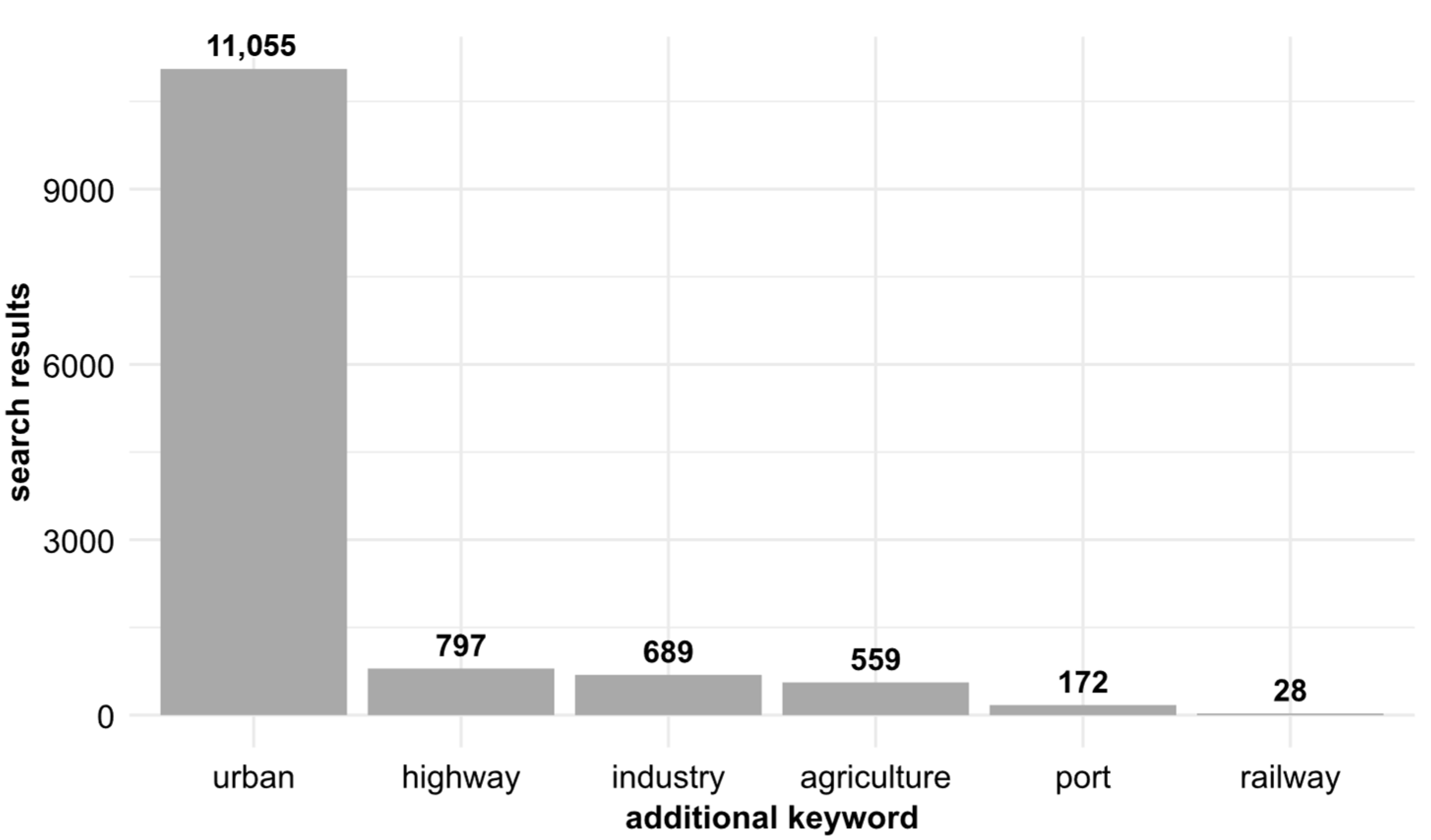
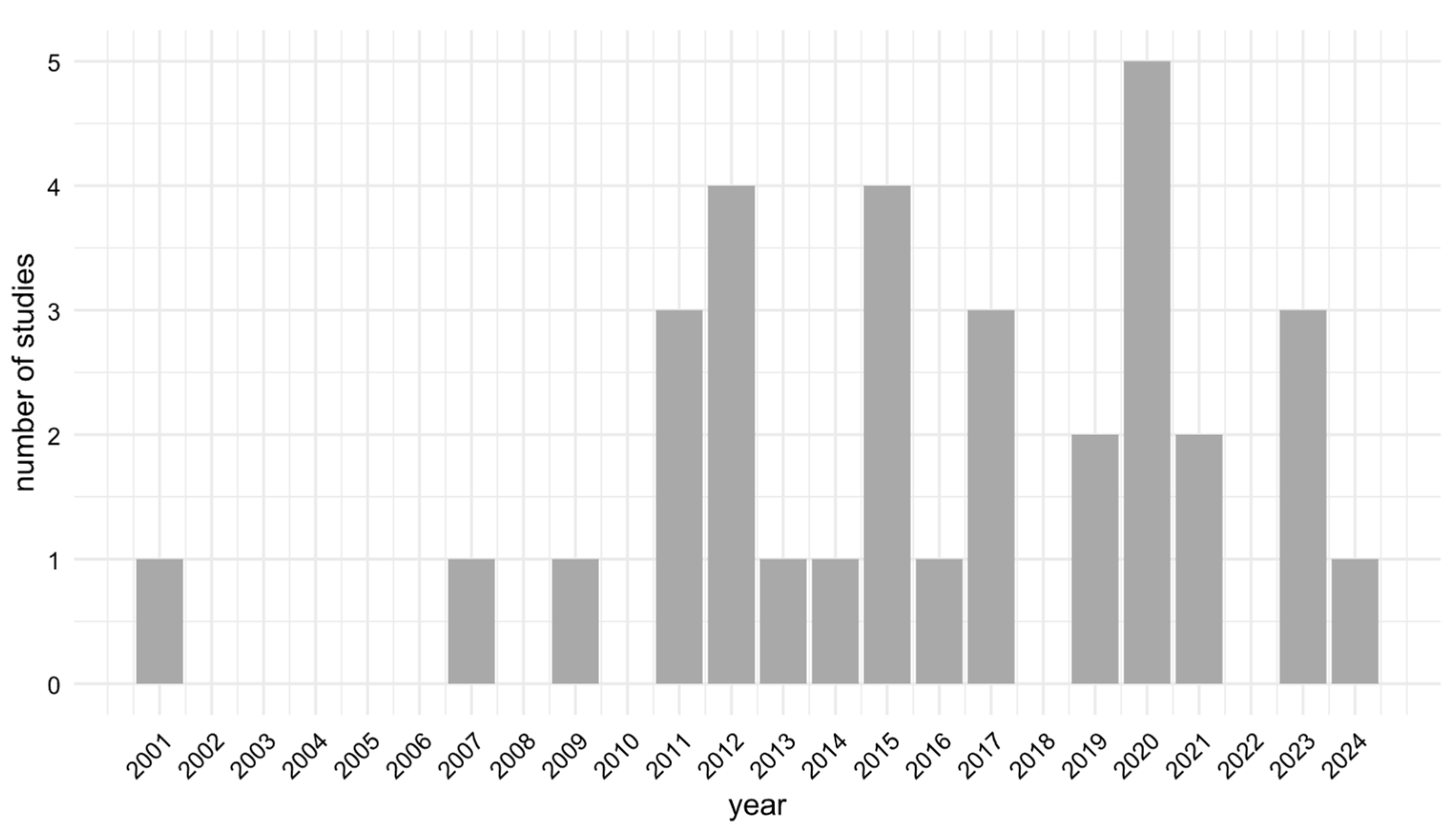
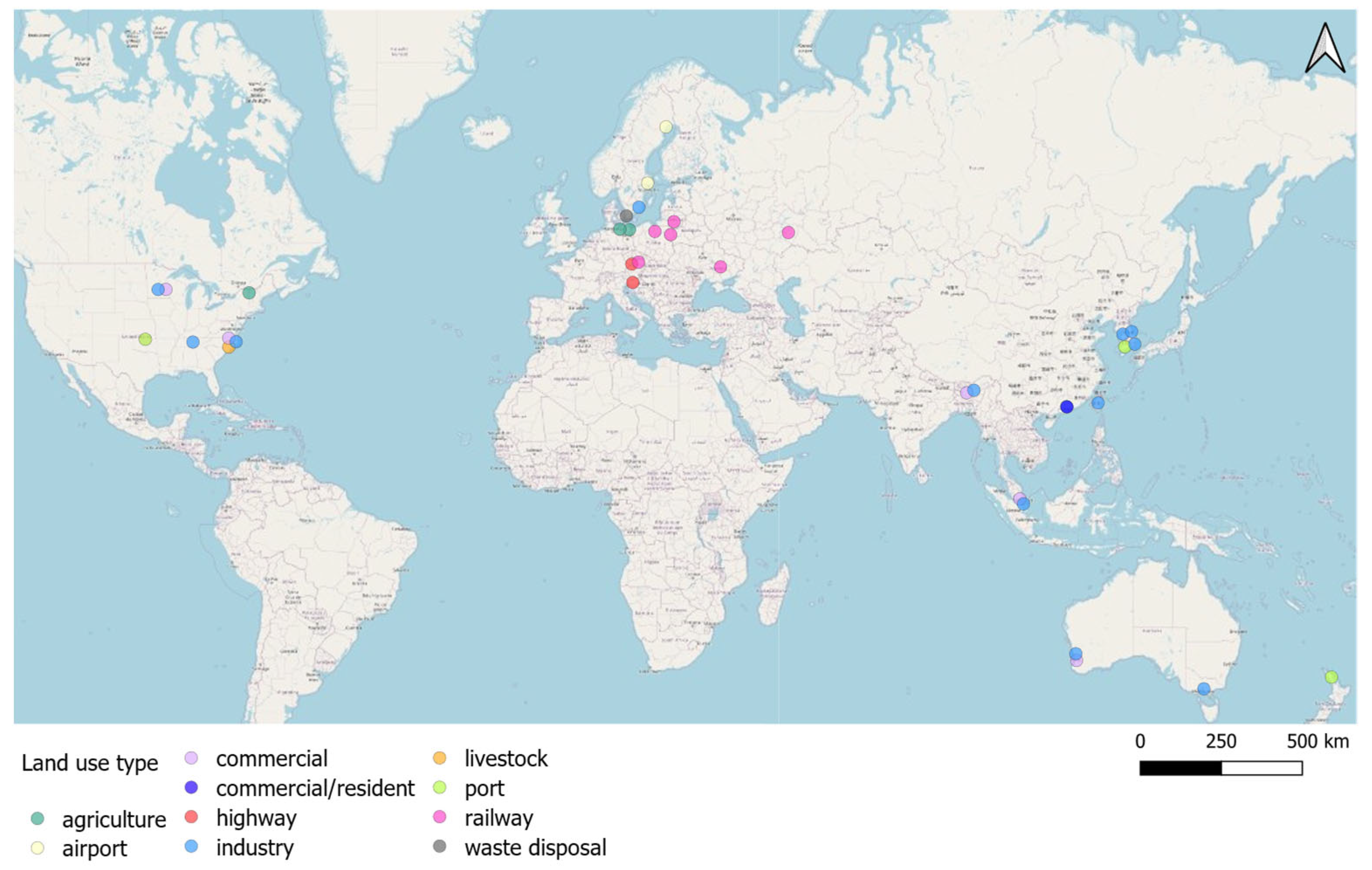

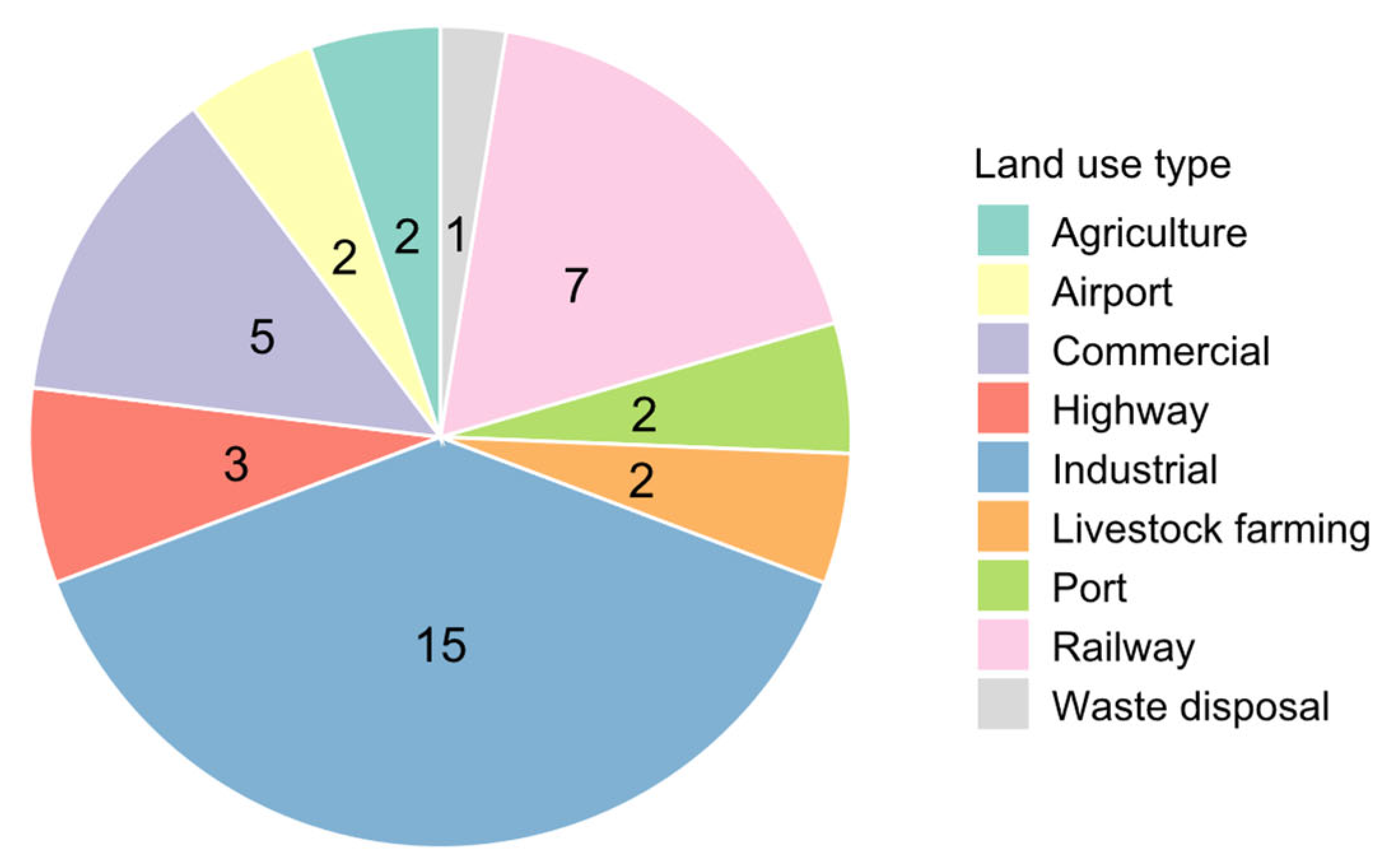
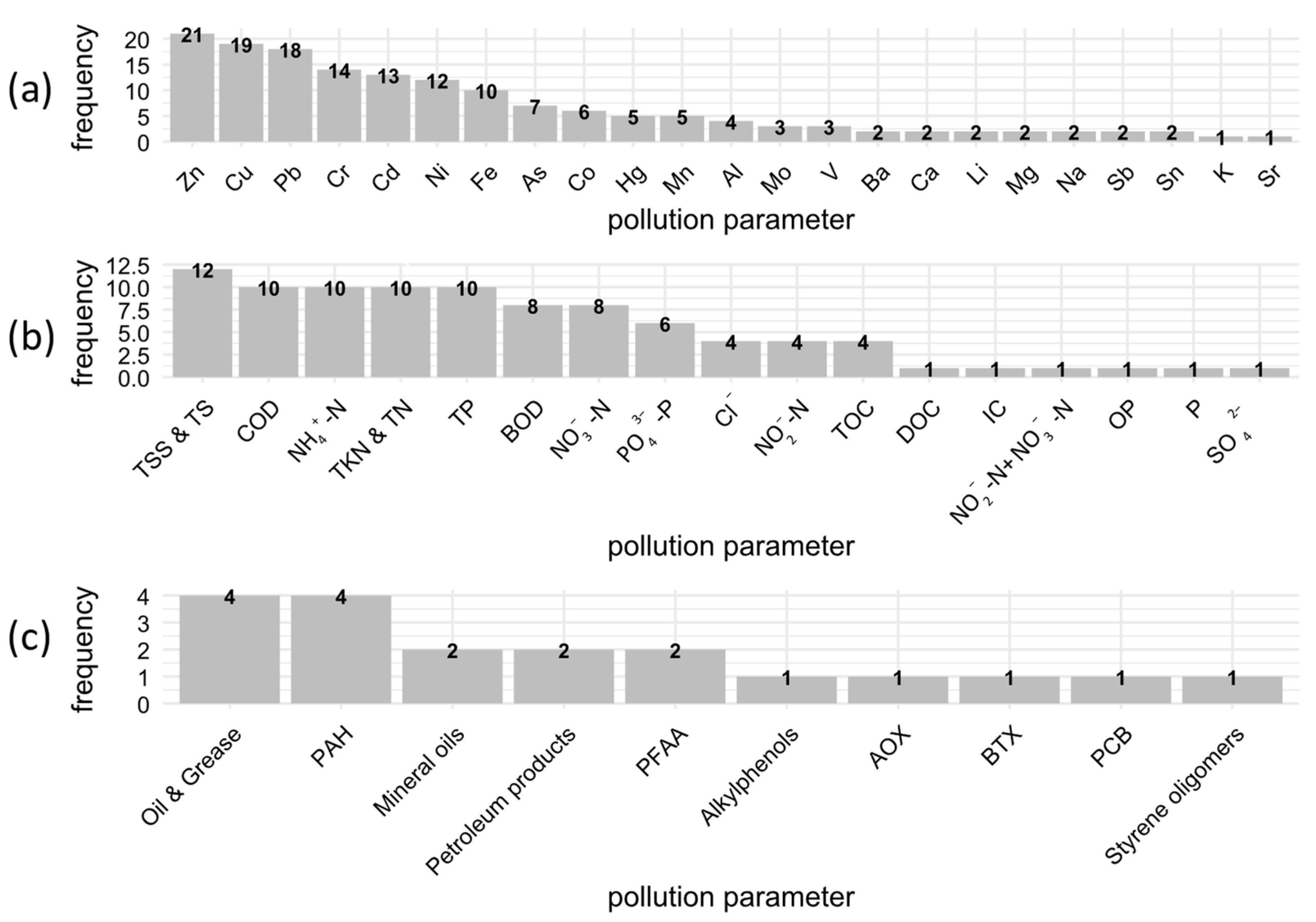

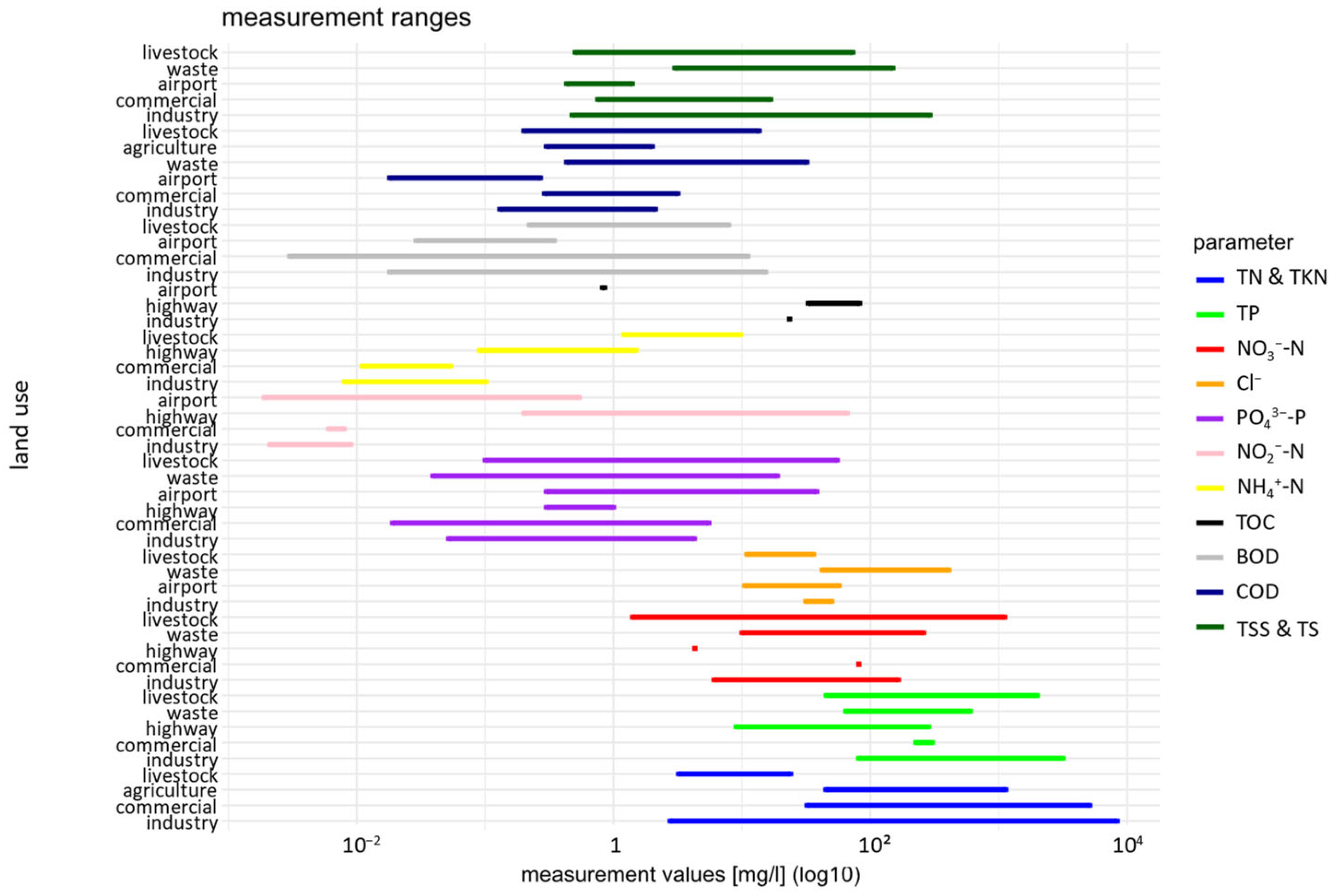

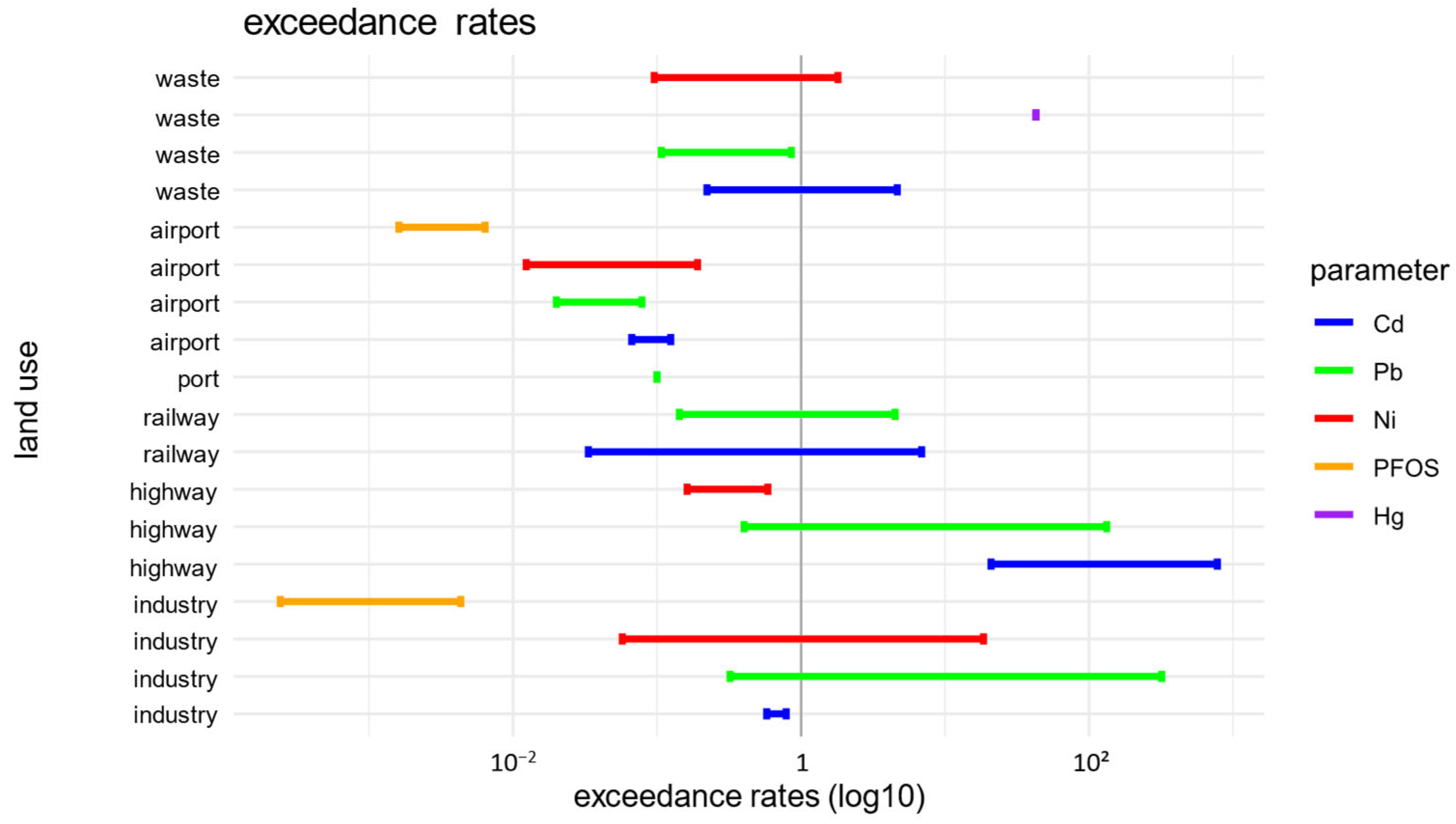
| Priority Substance | AA-EQS 1 | MAC-EQS 2 |
|---|---|---|
| Cd 3 | ≤0.00008 | ≤0.00045 |
| Pb | 0.0012 | 0.014 |
| Hg | - | 0.00007 |
| Ni | 0.004 | 0.034 |
| PAH | 1.7 × 10−7 | 0.00027 |
| PFOS | 6.5 × 10−7 | 0.036 |
| Land Use Type | Substance | Number of Values (n) | Exceedance of AA (n) | Exceedance of MAC (n) |
|---|---|---|---|---|
| Industry | Cd | 2 | 2 | 0 |
| Pb | 9 | 9 | 7 | |
| Ni | 3 | 1 | 1 | |
| PFOS | 2 | 2 | 0 | |
| Highway | Cd | 2 | 2 | 2 |
| Pb | 2 | 2 | 1 | |
| Ni | 2 | 1 | 1 | |
| Railway | Cd | 3 | 2 | 2 |
| Pb | 5 | 5 | 3 | |
| Port | Pb | 1 | 1 | 0 |
| Airport | Cd | 3 | 0 | 0 |
| Pb | 3 | 0 | 0 | |
| Ni | 3 | 2 | 0 | |
| PFOS | 2 | 2 | 0 | |
| Waste | Cd | 7 | 7 | 2 |
| Pb | 7 | 7 | 0 | |
| Hg | 1 | - | 1 | |
| Ni | 7 | 6 | 1 |
Disclaimer/Publisher’s Note: The statements, opinions and data contained in all publications are solely those of the individual author(s) and contributor(s) and not of MDPI and/or the editor(s). MDPI and/or the editor(s) disclaim responsibility for any injury to people or property resulting from any ideas, methods, instructions or products referred to in the content. |
© 2025 by the authors. Licensee MDPI, Basel, Switzerland. This article is an open access article distributed under the terms and conditions of the Creative Commons Attribution (CC BY) license (https://creativecommons.org/licenses/by/4.0/).
Share and Cite
Potreck, A.; Tränckner, J. Stormwater Pollution of Non-Urban Areas—A Review. Water 2025, 17, 1704. https://doi.org/10.3390/w17111704
Potreck A, Tränckner J. Stormwater Pollution of Non-Urban Areas—A Review. Water. 2025; 17(11):1704. https://doi.org/10.3390/w17111704
Chicago/Turabian StylePotreck, Antonia, and Jens Tränckner. 2025. "Stormwater Pollution of Non-Urban Areas—A Review" Water 17, no. 11: 1704. https://doi.org/10.3390/w17111704
APA StylePotreck, A., & Tränckner, J. (2025). Stormwater Pollution of Non-Urban Areas—A Review. Water, 17(11), 1704. https://doi.org/10.3390/w17111704








